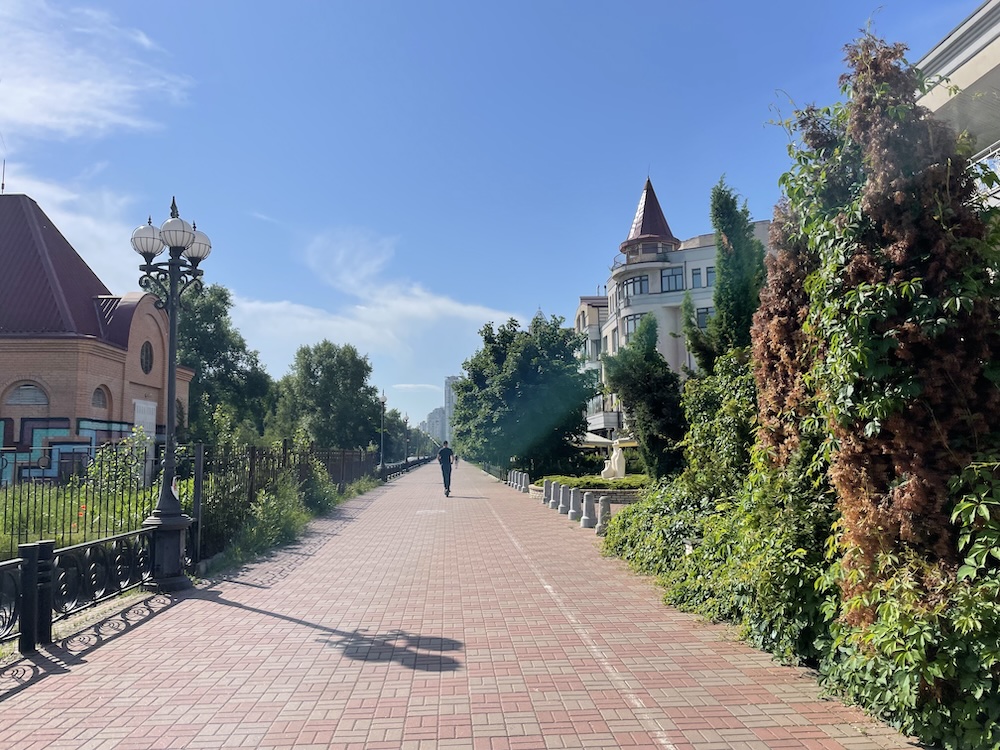
Kyiv is a beautiful and welcoming city for pedestrians!
(This post will make much more sense if you read A Journey of the Heart to Ukraine and A Journey of the Heart #2 first!)
6 June 2025
After a very disrupted night, the day began (again) around 9am. Katya and I walked to breakfast at a pleasant little eatery about a kilometer up a broad popular promenade. I have to take a moment to celebrate the relative subtlety of car culture here. We sat sheltering in a car from the threat of war. We rode an Uber home from the train station. And loud muscle cars can still be heard on the boulevards. But this culture is vastly less car-encumbered and car-dependent than my own. It feels European, refreshing, and quite lovely.
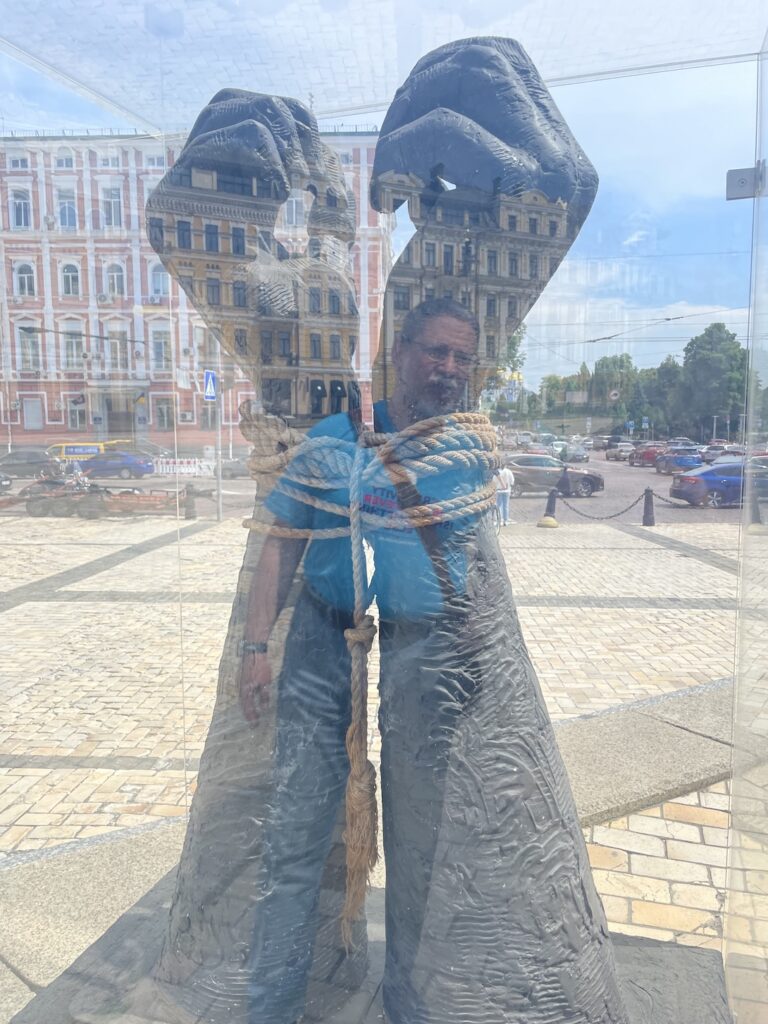
Valerii’s image, reflected in the glass protecting a sculptural icon of the quest for freedom.
Following breakfast, I took an Uber to meet Valerii Pekar, an author, university professor, and Ukrainian intellectual whose essays and podcasts I’ve explored during my pre-visit orientation. Valerii greeted me warmly, and I experienced that sensation of finally meeting someone face-to-face who has previously been seen as a sort of legend. We spent several hours together, with Valerii touring me around by foot to sites of historical and cultural importance.
Kyiv, like many ancient cities, was built at a crossroads. The Silk Road, tying Europe to the East, passed through here as a major east-west conduit. And the Dnipro River passes north to south, forming a major trade route linking the Baltic and Black seas. For this reason Kyiv – originally simply known as Rus – blossomed early, starting in perhaps 700-800 CE when nomadic groups in the area began to settle.
Kyiv long predated Moscow and for centuries was the cultural hub for the region. Present day Moscow, lacking a deep history independent of Kyiv, longs to possess Kyiv as a way to anchor its identity. This is one of three factors underlying the Russian obsession with Ukraine. Another is Ukraine’s turn toward Europe since the fall of the USSR, along with the embrace of self-determination and western social norms. The third is simply demographic: Russia needs people. This explains why Russians have kidnapped so many Ukrainian children: it seeks to raise them within a Russian value system to prop up their declining population.*
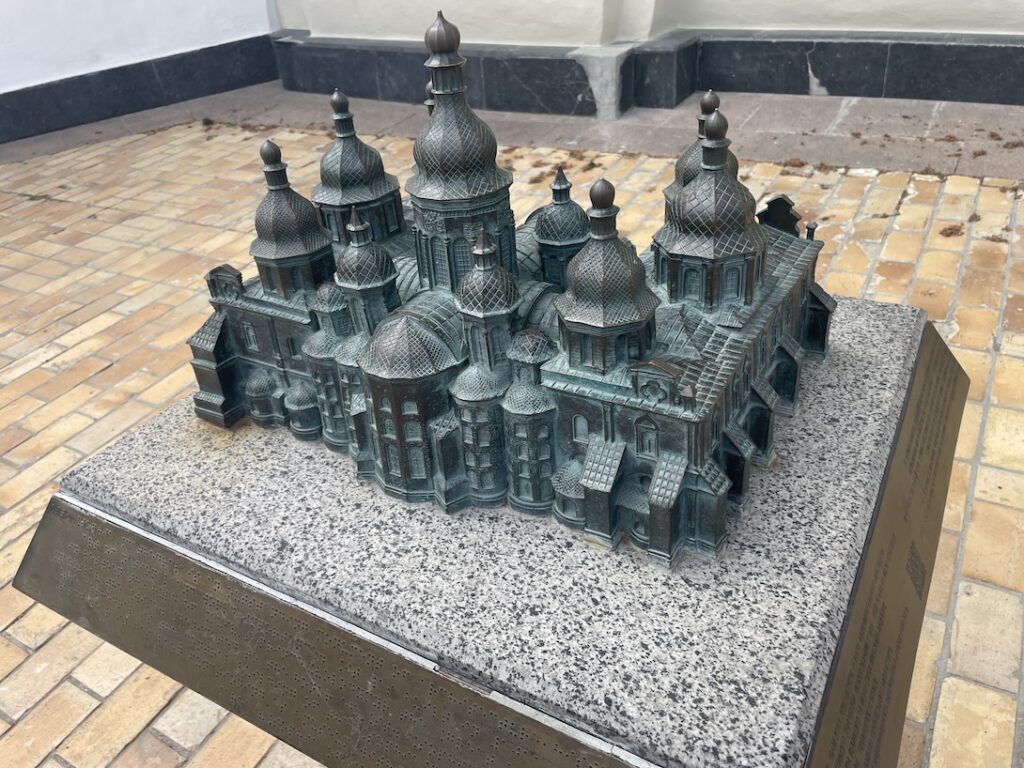
The St. Sophia Cathedral in miniature, cast in bronze.
This, and too many other nuggets of wisdom to recall, characterized my time with Valerii. I took notes on my phone as best I could as we walked in the blazing sun, but it was sipping from a fire hose. This man is an amazing font of information! Our first stop was the Golden Gate. This was the original southern border gate for the walled town of Rus, built as early as CE 500 but certainly by the 9th century, with documented influence of Nordic adventurers. Here Valerii described the figure of St. Volodymyr, the first recognized leader of Kyiv, who chose to be baptized in 988 to concentrate and formalize his power among the faithful.
Interestingly, Volodymyr is the first name of Ukraine’s current president. Spelled as Vladimir, it’s also the first name of Russia’s president. It appears in German as Waldemar and in the realm of Harry Potter as Voldemort. (Not to mention Vlad the Impaler, also known as Vlad Dracula!)
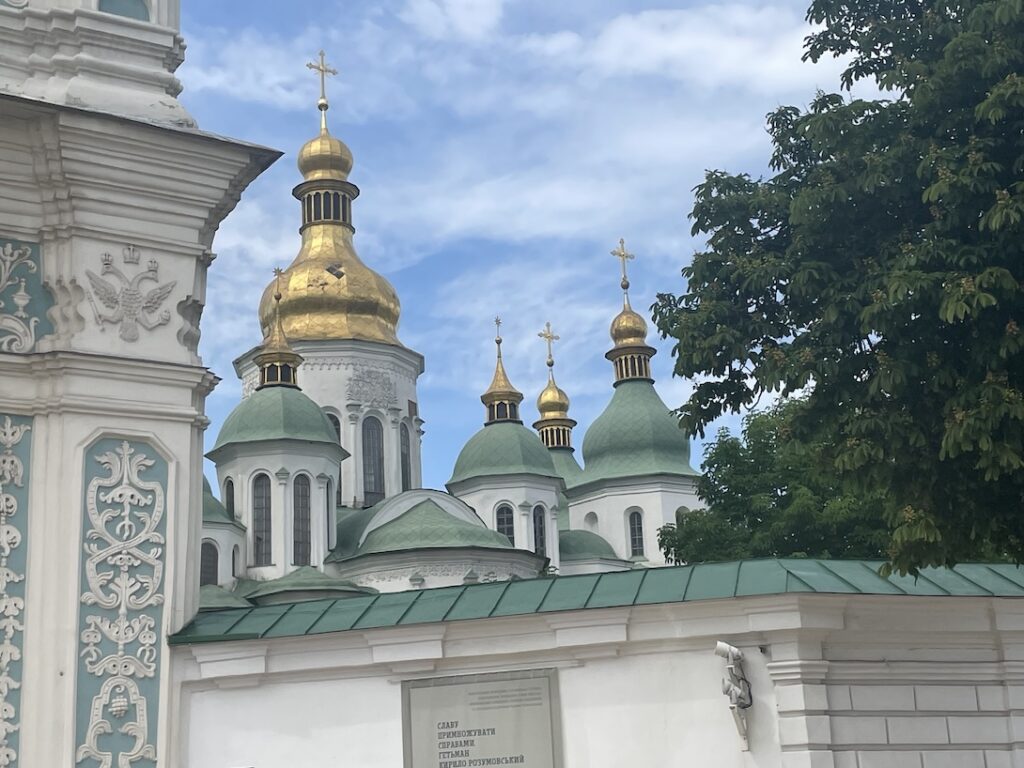
St. Sophia: a historical, symbolic, and architectural wonder!
From the Golden Gate Val walked me to the Cathedral of St. Sophia, along the way expressing his intent to share both ancient and current stories of Ukraine. He definitely did both during our time together, but it was quite a mix; the linearity of his stories aligned more with our path between landmarks than a discernable chronology. Nonetheless he was extremely well informed and very patient. I absorbed as much as I could.
The profound glory of St. Sophia is no accident. In its early days, Kyiv competed for influence with the city of Byzantium, now known as Istanbul. There, a grand cathedral was built honoring Sophia, known to this day as Sophia Hagia. Jaroslav the Wise in the 11th Century wanted Kyiv to rival the great Byzantium to the south, so he established this edifice in 1037 as a sibling to the cathedral there. We couldn’t enter, but gazed upon it while studying a bronze scale model near the front gate. This immense edifice, Valerii informed me, is the spiritual capital of the country, representing Ukraine’s autonomy: Another reason Putin wants to own Kyiv.
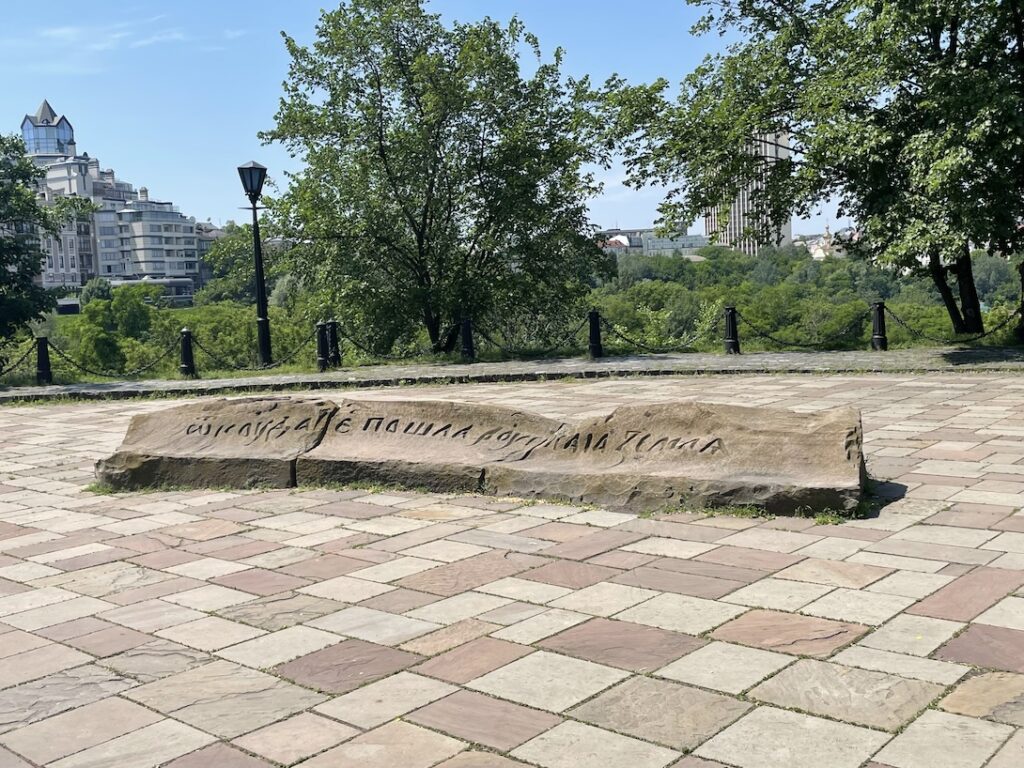
This stone was placed in Kyiv over a millenium ago!
Valerii and I walked to a number of other significant landmarks, including the cornerstone of the ancient city, where he told me of the three cities of early Rus: One, on the hill where we stood, was the center of government, rulers, military, and administration. The second, closer to the river, was the center of commerce and artisans, animated by people of all sorts coming and going. The third city was the spiritual center surrounding the cave monastery at Lavra, then at some distance outside the town proper. I learned that the first written record of this city was found in a Jewish text, unearthed by a Ukrainian archaeologist near Cairo in the 20th Century.
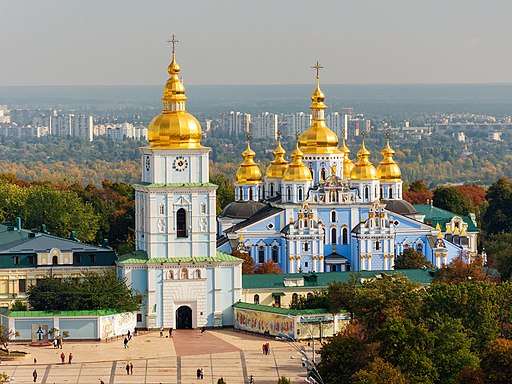
St. Michael’s Golden Domed Cathedral, the home of the Ukrainian Orthodox Church. Photo credit Rbrechko, Wikipedia (Creative Commons license)
We also visited St. Michael’s Cathedral, another place of great historical value and national pride. I can’t begin to capture its thousand-year legacy, but can note that it was the reputedly the first cathedral with golden domes, that St. Michael is the patron saint of war victories, and that during the 1930’s the place was almost completely destroyed by Soviet secularists. The loving restoration of the structure in the 1990’s after Ukrainian independence is testimony as much to Ukraine’s dignity and autonomy as it is to the Orthodox faith it reflects.
In a plaza near St. Michael’s we visited a new sculpture, made of destroyed Russian military vehicles and giant letters spelling out, in English, FREEDOM. In the context of all the past invasions and occupations of Ukraine, this sculpture speaks compellingly of the determination and resilience of this proud population.
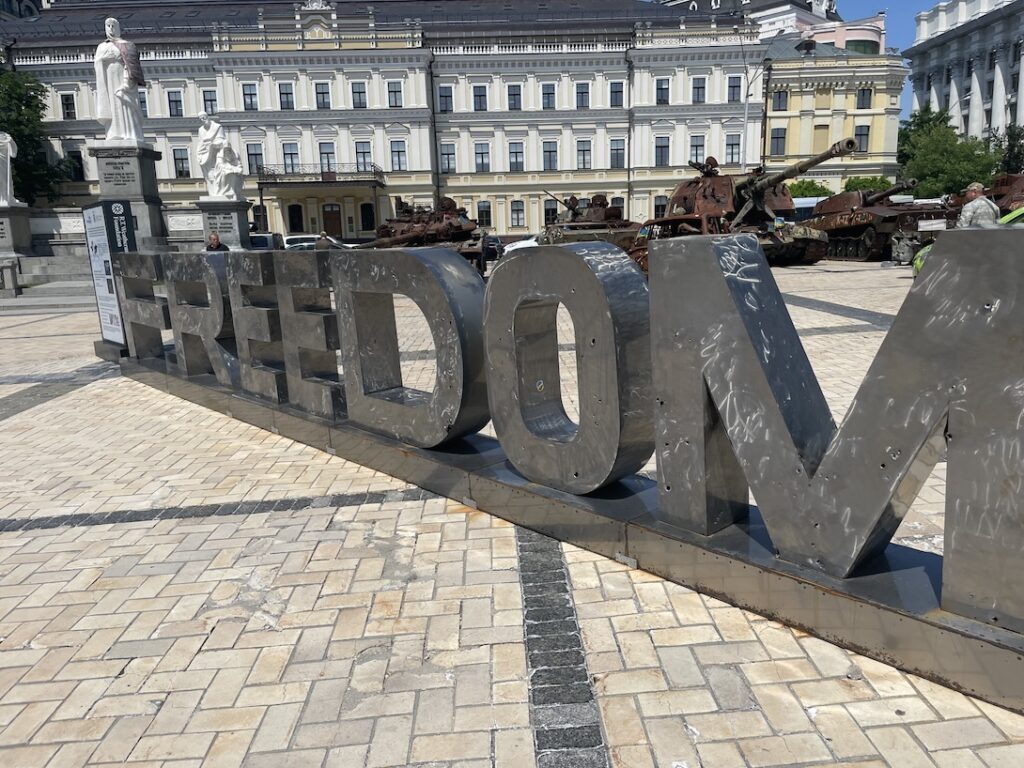
A sculpture newly installed in a plaza near St. Michael’s. The word Freedom — in English — is made from the remains of destroyed Russian war vehicles like those arching around the letters.
Also near St. Michael’s, Valerii showed me a memorial wall of images of some of Ukraine’s fallen heroes. There is something deeply moving about standing and staring at a wall that depicts a vast number of people who gave their lives to the defense of their country. I have visited the Vietnam Memorial in Washington DC, which evokes similar feelings: The vastness of the tragedy of war. The individual lives, so multidimensional in life, so much reduced in memoriam. The noble yet never adequate effort to honor the dead.
But this wall — in full color and reflecting a conflict that rages on, adding casualties by the day — feels more urgent and compelling to me: Patriots defending their homeland. The ongoing and immediate struggle for freedom. The realtime violence at the front line between contemporary Western democracy and an obsolete but still lethal hunger for empire. It’s hard not to see these fallen warriors as having given their lives not just for Ukraine but for democracy everywhere. Valerii and I took some time in silence at the memorial before moving on.
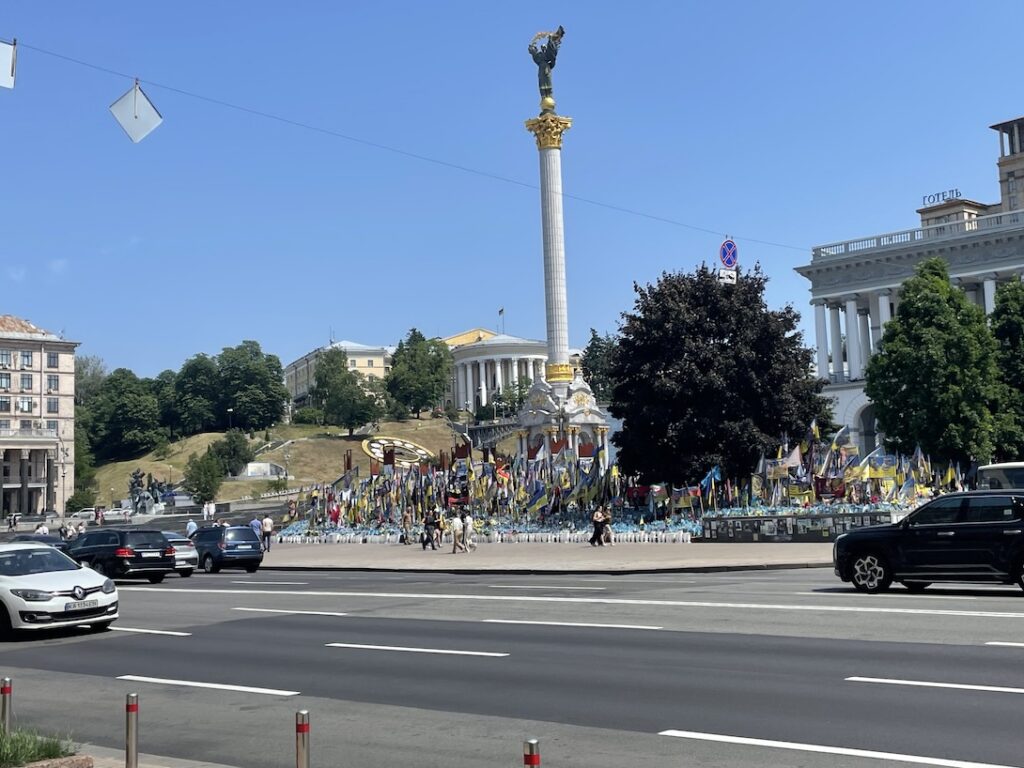
Maidan Square, the center of the peaceful 2013-2014 Revolution of Dignity that despite much government brutality, left President Yanukovych deposed.
By this time our feet were sore and it was lunchtime. We trekked down the hill, along the way passing Maidan Square, where the Maidan Uprising (also known as the Revolution of Dignity) began. This 2013-14 demonstration of Ukraine’s commitment to democracy was triggered by then-president Viktor Yanukovych’s betrayal of a Ukraine-EU agreement that had been passed by Parliament. Yanukovych turned his back on the agreement and the EU, choosing instead to strengthen ties to Russia. Months of massive but peaceful demonstrations followed — met with brutal violence — but they ultimately led to Yanukovych’s ouster on February 21, 2014.
Near Maidan, we stopped to eat and I had my first meal at a Crimean restaurant. It was a lovely taste of a culture within a culture, a celebration of an ethnicity within Ukraine not unlike, say, eating at a Cajun restaurant in the USA. A reminder: Crimea has been under Russian occupation for ten years, so eating here is itself almost an act of resistance. In Ukraine, that 2014 invasion marks the beginning of the war; what began in 2022 is referred to as “the full scale invasion.” The weak US response to the seizure of Crimea gave Obama an enduringly bad reputation in this country.
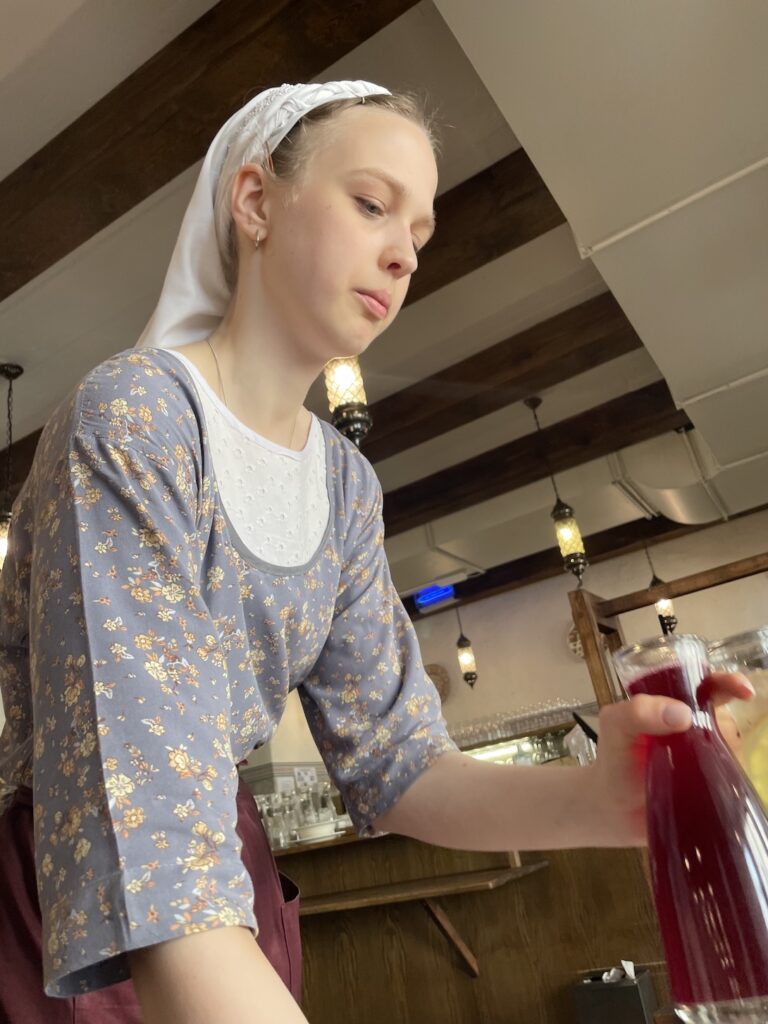
Servers in traditional Crimean attire added to the richness of the Crimean restaurant where we took lunch.
After a wonderful meal, Valerii and I parted ways and I rejoined Katya at a theatre nearby where she was facilitating a healing and awareness event. The theatre itself was a small black box affair on the third floor of a much grander theatre. Katya, a therapist by training, arranges these events to bring greater awareness, compassion, and emotional processing capacity to various groups. This one engaged perhaps 30-40 staff members from a local business. They watched the play, then engaged in facilitated dialog to develop a shared perspective on their experience.
Katya’s friend Natalya sat next to me to translate, but it was impossible, despite her sincere efforts, to pass along much detail. Nonetheless the drama was compelling and evocative.
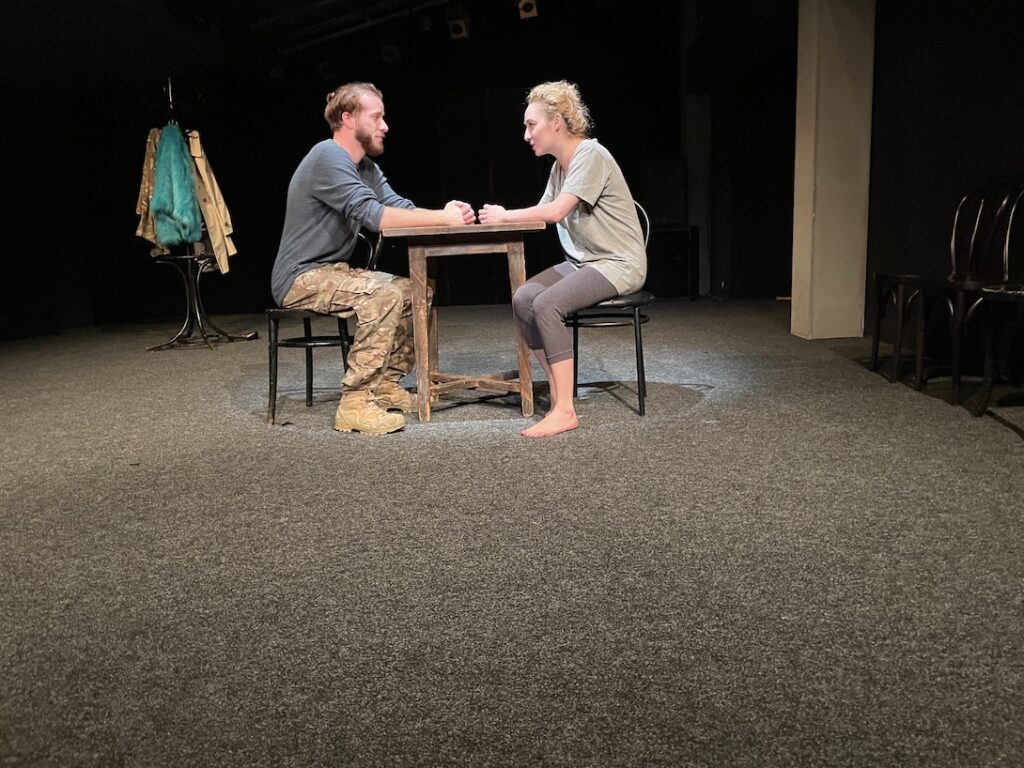
This performance was highly evocative despite my utter inability to grasp the lines.
The storyline of this play involved a man returning to his apartment after some time on the frontlines of the war, understandably agitated and in need of calm and solace. Yet his girlfriend, apparently doubtful about his return, had begun an affair with another man. Multiple layers of hardship and struggle were depicted. It was beautifully acted and highly emotional – even gut wrenching – to watch, even for one who could not grasp the dialog.
After it ended, Katya and several performers led a discussion with the audience. Again, I could only infer most of what transpired. But clearly the participants were moved, and most had comments and reflections to offer. It was beautiful to absorb nonverbal expressions regarding the impact of this performance from the audience – and also to witness Katya artfully contextualizing their comments and stories.
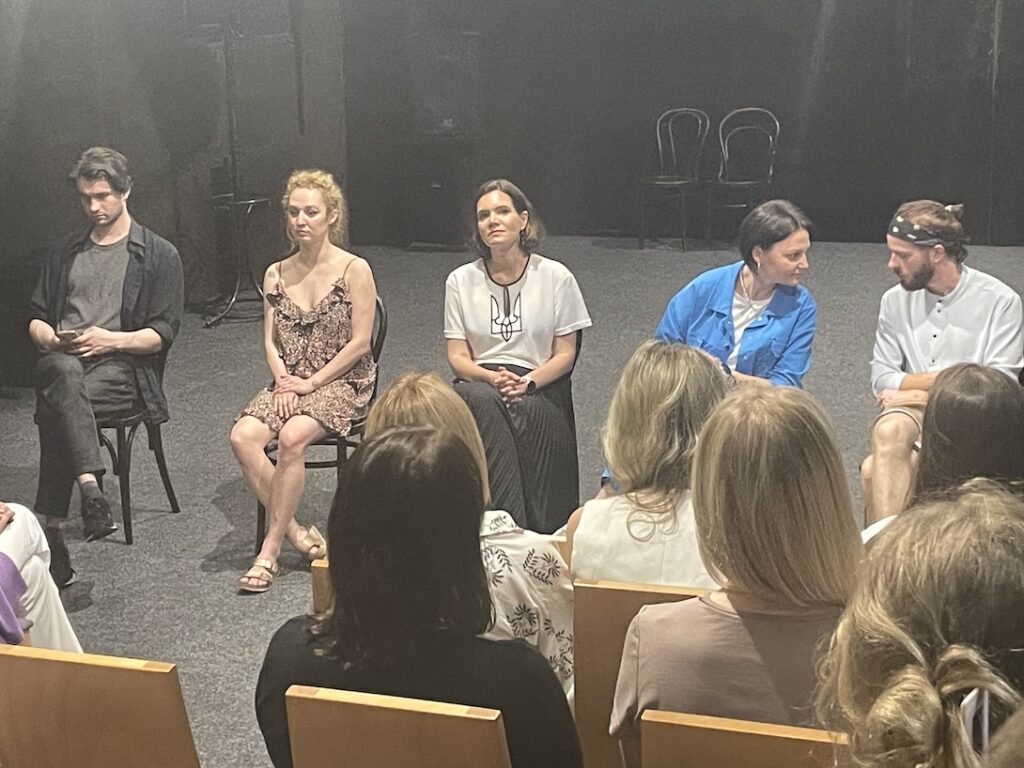
Debriefing the play was cathartic for the audience. Katya is in the center of this image.
It was a day full of urban exploration and learning. I look back upon it as an educative and enjoyable way to bond with this cosmopolitan city, which despite the specter of war appears to be humming along, vibrantly busy with government, commerce, arts and faith. It didn’t look like a city at war. But ending the day with this theatre event was a stark reminder that just below the surface, everyone in Ukraine is carrying the traumas of Russian cruelty and malevolence. By my exposure and allyship, I too have taken on this weight.
It remains to be seen how honorably and how far I can carry it.
[* I recently learned of the tragically immense scope of Russian kidnapping and indoctrination of Ukrainian children and youth. This is considered a war crime but has gone entirely unpunished. In fairness, I note that Ukraine has been accused of doing something similar, but the evidence of Russia’s immense kidnapping program is incontrovertible. ]
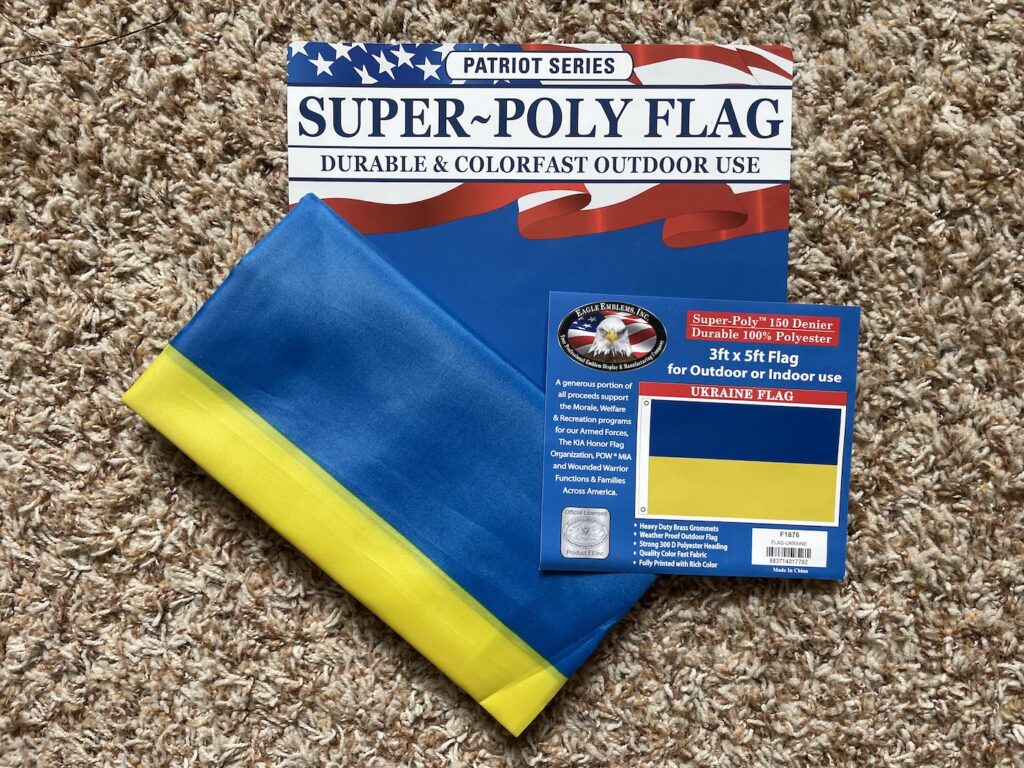
At home in Bellingham, a specialty shop sold me a Ukrainian flag. Note the “Patriot Series” logo and the “All-American” marketing motif. It may be worth noting that I recently marched in a demonstration carrying a sign that read: “Trump Stands With Russia. Patriots Stand with Ukraine!”
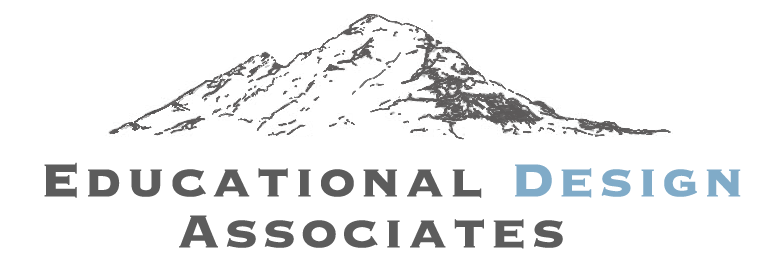
A Ukrainian refugee who stayed with me for the better part of a year painted a very violent picture of the Kyiv that she escaped from. Their apartment was bombed and she had a photo of the family sleeping in the collapsed basement. She described unimaginable scenes of human carnage on the streets and old people starving in their homes. She often commented on the clear air in Bellingham, compared to the pollution in Kyiv. Not surprisingly, she had rather intense PTSD.
It is comforting to hear that there is another side of Kyiv that still survives to carry the history of this beautiful and significant city.
It’s always good to hear other perspectives, Barbara. I didn’t get into all the different parts of the city, but nothing I saw compares with this description. One possible factor in this contrast is timing: We are now 3-1/2 years into the full scale invasion, and Kyiv has had time to settle into and adapt to the reality of war. Perhaps your contact was present in the first wave of the invasion? Consider the Bucha Massacre, for example, where a small city on the fringe of Kyiv was destroyed and nearly all its citizens murdered by Russian forces in the first month of the invasion. Many were also mutilated, tortured, raped, and otherwise brutalized. Such horrors are considered war crimes, though of course Russia has claimed that it did no such thing — despite all evidence. In any case, direct fighting is now contained far to the East, and Kyiv and other cities on the interior of Ukraine are simply being used as drone and missile targets to terrorize the population. I hope that my experience is more the norm now than hers…
Thanks for your willingness to dive into the generative meeting space of curiosity, integrity, emotional disturbance, community building, and uncertainty. You capture your experience well.
Many thanks for your response, Joseph.